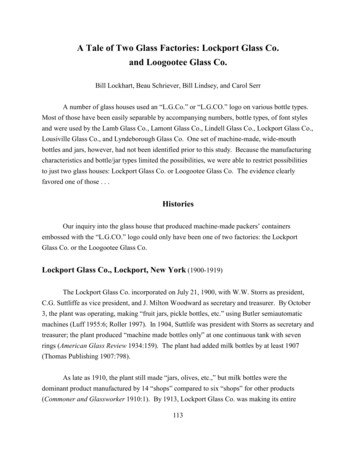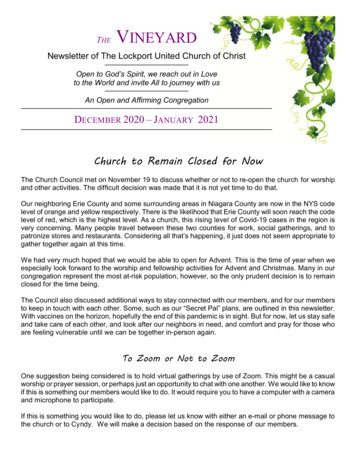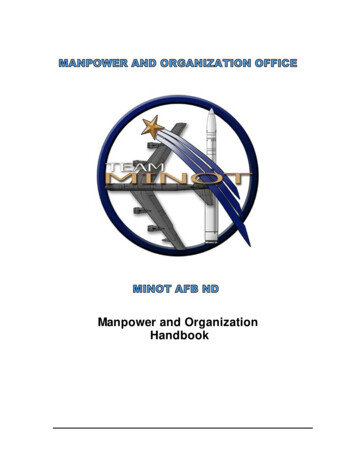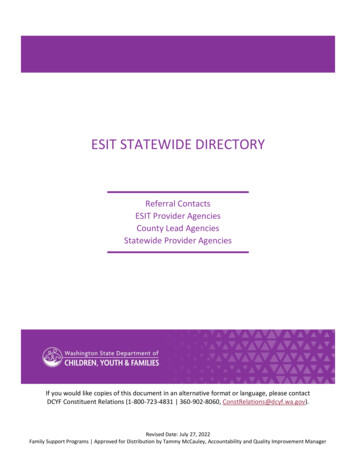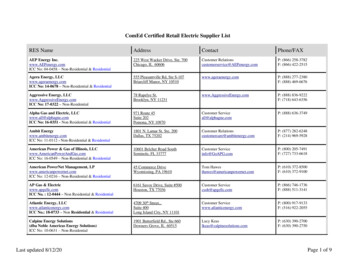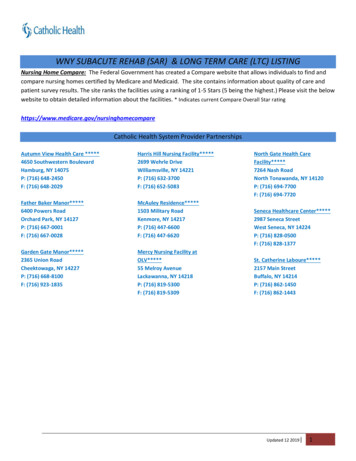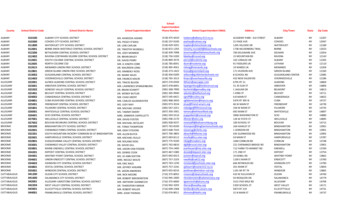
Transcription
DIVISION OF LOCAL GOVERNMENT AND SCHOOL ACCOUNTABILITYREPORT OF EXAMINATIONLockport City School DistrictProcurementAPRIL 2022 2021M-198
ContentsReport Highlights . . . . . . . . . . . . . . . . . . . . . . . . . . . . . 1Procurement . . . . . . . . . . . . . . . . . . . . . . . . . . . . . . . . 2How Should Officials Procure Goods and Services? . . . . . . . . . . 2Officials Could Not Demonstrate That the Competitive BiddingRequirements Were Always Followed in a Fair orTransparent Manner. . . . . . . . . . . . . . . . . . . . . . . . . . . 4Professional Services Were Not Always Procured in aCompetitive Manner . . . . . . . . . . . . . . . . . . . . . . . . . . . 7Written Quotes Were Not Always Obtained in Accordance Withthe District’s Procurement Policy . . . . . . . . . . . . . . . . . . . . 8What Do We Recommend? . . . . . . . . . . . . . . . . . . . . . . . 9Appendix A – Response From District Officials . . . . . . . . . . . . 11Appendix B – OSC Comments on the District’s Response. . . . . . 17Appendix C – Audit Methodology and Standards . . . . . . . . . . . 18Appendix D – Resources and Services. . . . . . . . . . . . . . . . . 20
Report HighlightsLockport City School DistrictAudit ObjectiveDetermine whether Lockport City SchoolDistrict (District) officials procured goods andservices in accordance with the District’sprocurement policy and applicable statutes.Key FindingsDistrict officials did not demonstrate thatcertain goods and services were procured inaccordance with the New York State GeneralMunicipal Law (GML) or the District’sprocurement policies.llDistrict officials could have used a moretransparent procurement process fora 3.3 million security enhancementproject. They did not seek competitionfor a facial/object recognitionsoftware license, prior to adopting astandardization resolution. We alsofound the resolution’s language to beinaccurate and misleading.llOfficials could not demonstrate that theycomplied with competitive requirementswhen awarding two contracts totaling 240,000 pursuant to the exceptionto GML Section 103[16] known as“piggybacking.”llllOfficials did not seek competition forfour professional service contractstotaling 238,000.Officials did not obtain the requirednumber of written quotes for threepurchases totaling 46,000.Key RecommendationsBackgroundThe District serves the City of Lockport and theTowns of Lockport, Cambria and Pendleton inNiagara County.The Board of Education (Board) is composedof nine members and is responsible for thegeneral management and control of theDistrict’s financial and educational affairs. TheSuperintendent of Schools is the chief executiveofficer and is responsible for the District’s day-today management under the Board’s direction.The Assistant Superintendent for Financeand Management Services is responsiblefor financial services and is also the Boardappointed purchasing agent responsible forensuring all goods and services are procuredin the most prudent and economical mannerpossible and in compliance with establishedpolicies and procedures.Quick Facts2020-21 Expenditures 79.7 millionApproximate Purchases Subject toCompetitive Procurement Process 38.8 millionPurchases ReviewedEnrollment 2019-20 8.1 million4,328Audit PeriodJuly 1, 2018 – September 2, 2021. We extendedour audit period back to June 2017 to review theprocurement of software that became part of alarger purchase contract in 2018.llDocument the analysis when using the “piggybacking” exception to competitive bidding to ensurethe District awards the contract in a manner consistent with GML.llComply with the District’s procurement policy that requires the use of request for proposals tosolicit professional services.llObtain the required number of written quotes as required by the District’s procurement policy.District officials generally agreed with our recommendations. Appendix B includes our comments onissues raised in the District’s response.Of f ic e of t he New York State Comptroller1
ProcurementHow Should Officials Procure Goods and Services?GML Section 103 generally requires school districts to solicit competitive bidsfor purchase contracts that exceed 20,000 and contracts for public work thatexceed 35,000. In determining whether the dollar threshold will be exceeded, aschool district must consider the aggregate amount reasonably expected to bespent on “all purchases of the same1 commodities, services or technology to bemade within the twelve-month period commencing on the date of the purchase,”whether from a single vendor or multiple vendors.GML sets forth certain exceptions to competitive bidding. One exception, oftenreferred to as “piggybacking,” allows school districts to procure certain goods andservices through the use of other governmental contracts.2 In some cases, grouppurchasing organizations (GPOs) may advertise the use of such governmentalcontracts to other local governments. This “piggybacking” exception allows schooldistricts to benefit from the competitive process already undertaken by otherlocal governments. However, when procuring goods and services in this manner,officials must review the contract to ensure it was awarded in a manner consistentwith the exception set forth in GML Section 103 [16].In addition, school district officials should perform a cost-benefit analysis beforeusing the exception. This will help ensure that the school district is furthering theunderlying purposes of the exception, and that the procurement is consistent withthe purposes of competitive bidding. The analysis should be used to demonstratewhether “piggybacking” is cost effective and should consider all pertinent costfactors, including any potential savings on the administrative expense that wouldbe incurred if the school district initiated its own competitive bidding process.Finally, a school district should maintain appropriate documentation to allow for athorough review of the decision to use the “piggybacking” exception to competitivebidding by school district officials. This documentation may include such itemsas copies of the contract, analysis of the contract to ensure it meets each ofthe prerequisites set forth in the exception, and cost savings analysis includingconsideration of other procurement methods.1 For this purpose, commodities, services or technology that are similar or essentially interchangeable shouldbe considered “the same.”2 GML authorizes, as an exception to competitive bidding, political subdivisions to purchase apparatus,materials, equipment and supplies, and to contract for services related to the installation, maintenance orrepair of those items, through the use of contracts let by the United States or any agency thereof, any state orany other political subdivision or district therein. For the exception to apply, certain prerequisites must be met,including: (1) the contract must have been let by the United States or any agency thereof, any state or anyother political subdivision or district therein; (2) the contract must have been made available for use by the othergovernmental entity and (3) the contract must have been let to the lowest responsible bidder or on the basis ofbest value in a manner consistent with GML Section 103 (see, GML Section 103 [16]).2Of f ic e of t he New York State Comptroller “[P]iggybacking,”allows schooldistricts to procurecertain goods andservices throughthe use of othergovernmentalcontracts.
With respect to drafting bid specifications for the solicitation of competitive bids,school district officials generally have broad discretion to fix reasonable standardsand requirements that competitive bidders are obliged to observe. To help ensurethat all bidders are competing on a common and equal basis, school districtofficials are generally restricted from including specific brand names when draftingbid specifications.However, brand name products may be specified to the exclusion of othersif a school district has adopted a proper standardization resolution. Pursuantto GML Section 103(5), upon the adoption of a resolution by at least threefifths vote, stating that, for reasons of efficiency or economy, there is a needfor standardization, the school district may award the purchase contract for aparticular type or kind of equipment, material, supplies or services. The resolutionmust contain a full explanation of the reasons for its adoption. Upon the adoption,the school district may provide in its specifications for a particular make or brandto the exclusion of all other competitors. Nonetheless, a resolution standardizinga particular brand or service solely because of the subjective preference of schooldistrict officials, or because in the opinion of school district officials a particularmake is more economical, better built or more durable than other makes, is notsufficient. Rather, the standardization resolution should recite why, by objectivefacts, efficiency or economy will be served.3Writtenprocurementpolicies andproceduresalso provideguidance toemployees. GML Section 104 also requires a board to adopt written policies and proceduresgoverning the procurement of goods and services, such as professional services,that are not subject to the competitive bid requirements of GML.4 Such policiesand procedures help ensure the prudent and economical use of public money,as well as help guard against favoritism, improvidence, extravagance, fraud andabuse. Written procurement policies and procedures also provide guidance toemployees involved in the procurement process and help ensure that competitionis sought in a reasonable and cost-effective manner.These policies and procedures should indicate when officials must seekcompetition and outline procedures for determining the competitive methodthat will be used by the school district. For example, competitive methods couldinclude issuing a request for proposals (RFP) or obtaining written or verbalquotes. The procurement policy, however, may set forth circumstances when, ortypes of procurements, in the sole discretion of the school district, that solicitationof alternative proposals or quotes will not be in the best interest of the schooldistrict. The purchasing agent should monitor and enforce compliance with theschool district’s procurement policies and procedures, such as ensuring officials3 GML Section 103(5)4 GML Section 104(b)Of f ic e of t he New York State Comptroller3
have obtained responses to an RFP or the appropriate number of quotes prior toapproving a purchase, as well as maintaining adequate documentation to supportand verify the action taken.Officials Could Not Demonstrate That the Competitive BiddingRequirements Were Always Followed in a Fair or Transparent MannerWe reviewed 17 contracts, totaling approximately 7.7 million, that were subjectto the competitive bidding requirements of GML Section 103. We found thatofficials could not demonstrate that competition was sought in a fair or transparentmanner prior to awarding a 3.3 million public works contract and could notdemonstrate that they complied with the competitive bidding requirements of GMLwith respect to the award of two contracts totaling 240,000.Security Enhancement Project – In March 2018, the District competitively bid andawarded a 3.3 million contract for the purchase and installation of various schoolsecurity enhancements.5 This security enhancement project (Project) included,among other items, updates to the District’s mass notification systems, protectiveglass film for doors and windows and a video surveillance system that includedthe use of facial/object recognition software.Prior to competitively bidding for the Project, the District conducted a series ofactions with respect to researching and subsequently selecting the District’s videosurveillance system and facial/object recognition software. For example, theDistrict hired a technology consultant (Consultant) to help research and advisethe District regarding the use of facial/object recognition software for a videosurveillance system. On behalf of the District, the Consultant issued a requestfor information (RFI) seeking information on facial/object recognition softwareto operate in conjunction with an existing or new video surveillance system.According to the RFI, responses were due back to the Consultant on June 20,2016, four days after the RFI had been issued to vendors.According to District officials, the RFI was sent to multiple vendors, whodiscussed the RFI with the Consultant and initially indicated they could providethe video analytic solution described in the RFI to the District, but they would needto develop the software and/or the cost for the facial/object recognition softwarewas not within the District’s budget. We requested supporting documentation, butthe Consultant and District officials were unable to provide us with documentation.5 Funding for the District’s school security enhancement project derived from funds appropriated to the Districtby the Smart School Bond Act (SSBA). The SSBA, which was approved by New York State voters during the2014-15 enacted State budget, authorized the issuance of two billion dollars in general obligation bonds tofinance improved educational technology and infrastructure to improve learning opportunities for studentsthroughout New York State. Amongst the items that could receive SSBA funding were capital projects to installhigh-tech security features in school buildings, including but not limited to video surveillance, emergencynotification systems and physical access controls. The District was allocated 4,274.931 in SSBA funds.4Of f ic e of t he New York State Comptroller
Approximately one year later, the District, on June 23, 2017, entered into a oneyear facial/object recognition software licensing agreement (license agreement)to be used in conjunction with cameras at the District’s high school.6 Althoughnot legally required to do so, no competition was sought by the District prior toawarding the license agreement.On February 7, 2018, the Board adopted a standardization resolution with respectto the District’s facial/object recognition software. According to the resolution,standardizing the facial recognition software would achieve efficiencies forthe District by using the District’s existing video surveillance system. With theadoption of the standardization resolution, the bid specifications for the Projectincluded the requirement that bidders use the facial/object recognition softwarepreviously selected at the high school which was only available to purchase froma single distributor/company.However, we found that the language of the Board-adopted standardizationresolution was inaccurate and misleading. For instance, the standardizationresolution stated that the District had previously conducted an RFP processto select the vendor awarded the software license agreement. However, uponreviewing the language of the RFP, we determined that the RFP referred toin the resolution had only sought proposals for the hardware (i.e., monitoringservers and database server) that would be used with the facial/object recognitionsoftware. When we brought this issue to the attention of District officials, wewere told they were under the impression the RFP had been issued for both thesoftware and hardware affiliated with the video surveillance system. Further,according to documents provided by the District, responses to the RFP were duethe day after the RFP was issued (i.e., August 25, 2017). The District receivedone proposal, which was from the vendor who had previously been awarded thelicense agreement on June 23, 2017.Given the circumstances above, as a best practice, seeking competition for theinitial facial/object recognition software may have provided for a more transparentprocurement process. For instance, while GML does not require competitivebidding when awarding a license agreement, we have generally recommendedusing some form of competition (whether that be an RFP or some less formalmethod) prior to awarding the license agreement to help assure the license isunder terms and conditions that are fair and reasonable.7 Furthermore, we havestated that a municipality may standardize on a particular make of software ifthe municipality can objectively demonstrate that efficiency and economy will6 According to documents provided by the District, the District authorized the one-year software licenseand servers, which was outside of the SSBA project scope, in order to expedite implementation of the facialrecognition technology while awaiting SED approval for use of the District’s allocated SSBA funds.7 See, e.g., Opn No. 88-60.Of f ic e of t he New York State Comptroller5
be served.8 Here, the District’s standardization resolution indicates that theintent of standardizing the facial/object recognition software was to achieveefficiencies and economies through the District’s existing systems. However, nodocumentation was provided to us by the District or the Consultant to support thenotion that no other facial/object recognition software was available on the marketthat could meet the District’s needs and budget. Therefore, while we recognizethe importance of standardizing the District’s facial/object recognition software forthe Project, seeking competition for the initial software license agreement, prior tousing the standardization resolution, may have provided for a more transparentprocurement process.Group Purchasing Organizations – District officials did not verify that eachprerequisite was met prior to awarding contracts pursuant to the “piggybacking”exception. As noted above, the “piggybacking” exception to competitive biddingallows school districts to procure certain goods and services through the use ofother governmental contracts. In order for the exception to apply, the District mustdetermine that the following prerequisites are met:(1) the District must verify that the contract was awarded by anothergovernmental entity;(2) that the contract was made available for use by the other governmentalentity; and(3) the contract was originally awarded to the lowest responsible bidder or onthe basis of best value in a manner consistent with GML.9The District entered into a purchase contract for furniture, totaling 118,000, anda contract for public work, totaling 122,000, for materials and installation of anathletic track without competitive bidding. Instead, each contract was awarded bythe District to a vendor who was listed as an eligible contractor on certain GPOwebsites. Although District officials expressed that each contract qualified underthe “piggybacking” exception, officials did not verify that each of the prerequisiteswas met prior to awarding each contract. As a result, District officials did notensure that each contract was properly bid and awarded in a manner consistentwith the exception set forth in GML. District officials also could not demonstratethat they had performed any type of analysis to determine whether procuring thegoods and services through a GPO was cost effective. The purchasing agent wasnot aware additional steps should have been taken and was under the impressionthat the District could procure goods and services using GPO contracts with noadditional review.8 See, Opn No. 88-35.9 GML Section 103(16)6Of f ic e of t he New York State Comptroller
When officials do not procure goods and services in a way that fosterscompetition and do not provide transparency in the procurement process, thereis an increased risk that the procurement could be influenced by favoritism, fraudor corruption, and that taxpayer dollars are not expended in the most efficientmanner.Professional Services Were Not Always Procured in a CompetitiveMannerProfessional services, which is a well-established exception to competitivebidding, generally involve specialized skill, training and expertise, use ofprofessional judgment and/or a high degree of creativity. For example,professional services include legal, architectural and accounting services.According to the District’s procurement policy, the District is required to usean RFP process to protect the District’s interests and to avoid any impropriety.While the policy acknowledges that the lowest bidder need not be selected, theDistrict should adequately document its selection process to demonstrate itseconomic and practical use of public money and to ensure fair competition. TheDistrict’s “purchasing regulations” also includes a requirement that the Districtobtain written proposals for professional services. However, the regulations doacknowledge that proposals will not be required if the professional service, due toits confidential nature, does not lend itself to procurement through solicitations.We reviewed the procurement of six professional service contracts, totaling 353,520. We found that District officials did not seek competitive proposals,as required by the District’s procurement policy and regulations, for four (67percent) of the professional service contracts we reviewed, totaling approximately 238,000.The purchasing agent told us that these service providers had been providingservices to the District for so long (between six and 14 years) that they could notlocate the original RFP or confirm if one was ever done. For example, one serviceprovider, with a contract totaling 16,000, had been providing the District withacademic support services (developing academic improvement plans) for morethan 14 years. The purchasing agent told us that because the service providerhad knowledge of the District and was familiar with the operations, officialscontinued using the same provider without seeking competition or issuing an RFP.Of f ic e of t he New York State Comptroller7
The purchasing agent also told us that instead of issuing RFPs for existingprofessional service contracts, informal reviews would be conducted to comparecontract rate increases of professional service providers to the Consumer PriceIndex10 to help ensure the services were still being offered to the District at areasonable rate.Although District officials indicated they are comfortable and satisfied in theirlong-standing relationships with these providers, soliciting these servicesthrough RFPs, as required by the District’s procurement policy, can help provideassurance that quality services are obtained under the most favorable terms andconditions possible and without favoritism. Further, using RFPs can increaseDistrict officials’ awareness of other service providers who could offer similarservices at a more favorable cost.Written Quotes Were Not Always Obtained in Accordance With theDistrict’s Procurement PolicyThe Board adopted a written policy for the procurement of goods and servicesnot subject to competitive bidding requirements. The District’s policy addresses,among other things, when the District is responsible for obtaining writtenquotes, RFPs or formal bids. In addition to the District’s written policies for theprocurement of goods and services, the District also maintains a documententitled “purchasing regulations.” Similar to the procurement policy, the“purchasing regulations” address when the District is responsible for obtainingwritten quotes, RFPs or formal bids.In some cases, we found that the policy was inconsistent with the “purchasingregulations.” For example, according to the District’s “purchasing regulations,” allpurchase contracts greater than 1,750, but less than 20,000, require the Districtto obtain three written or fax quotes. A similar provision is set forth for all contractsfor public works greater than 10,000 but less than 35,000. The District’s policy,however, states that written quotes are required for purchase contracts in excessof 1,500, but less than 20,000. Moreover, the policy indicates that public workscontracts require written quotes when the contract is in excess of 5,000, but lessthan 35,000.District officials did not always obtain the number of written quotes required bythe District’s procurement policy and the purchasing agent did not ensure officialscomplied with the policy. We reviewed purchases from seven vendors totaling 97,000 that were below the competitive bidding thresholds, to determine whetherofficials obtained quotes as required by the District’s policy. We found that District10 The Consumer Price Index (CPI) is a measure of the average change over time in the prices paid by urbanconsumers for a market basket of consumer goods and services. https://www.bls.gov/cpi/8Of f ic e of t he New York State Comptroller [U]singRFPs canincreaseDistrictofficials’awareness ofother serviceproviderswho couldoffer similarservicesat a morefavorablecost. .Districtofficials didnot alwaysobtain thenumber ofwritten quotesrequired bythe District’sprocurementpolicy. .
officials did not obtain the required number of quotes for three or 43 percentof purchases reviewed, totaling 45,628. These purchases included paintingservices ( 25,190), floor mats ( 10,438) and refinishing of a gym floor ( 10,000).According to the District’s policy, officials should have obtained three writtenquotes for all three of these purchases, but officials could not demonstrate thatthey obtained quotes or sought comparative pricing. District officials told us thatthey had attempted to obtain the required number of quotes but were unable toobtain quotes from three vendors due to low competition or lack of interest fromvendors; however, officials did not always adequately document their attempts toobtain quotes using the appropriate forms required by the District’s policy.Because District officials did not always follow the procurement policy andsolicit competition when procuring goods and professional services, there is anincreased risk that goods and services may not have been obtained for the bestvalue to ensure the most prudent and economical manner in the best interest oftaxpayers.What Do We Recommend?The Board should:1. Require the purchasing agent to enforce compliance with the Boardadopted procurement policy and GML bidding requirements.2. Revise the procurement policy to require that officials perform anddocument a cost-benefit analysis prior to “piggybacking” or using GPOcontracts and to review each contract to ensure the contract was properlybid and awarded in a manner consistent with GML.3. Ensure purchasing regulations are consistent with the Board-adoptedprocurement policy thresholds for procuring goods and services belowGML competitive bidding thresholds.District officials should:4. Document the analysis used to help ensure the contract is awardedin compliance with GML when “piggybacking” off other governmentcontracts.5. As a best practice, seek some form of competition prior to awardinglicense agreements to increase transparency and help assure the termsand conditions of the agreement are fair and reasonable.Of f ic e of t he New York State Comptroller9
6. Procure professional services in a competitive manner and issue an RFPfor professional services as required by the procurement policy and theregulations.7. Obtain and document the required number of quotes as required by theprocurement policy for all goods and services purchases below the biddingthreshold and document and retain attempts to obtain quotes using theappropriate forms.10Of f ic e of t he New York State Comptroller
Appendix A: Response From District OfficialsThe District’s response includes a reference to a page number in our draft report that has changed inthe processing of the final report.SeeNote 1Page 17Of f ic e of t he New York State Comptroller11
SeeNote 2Page 17SeeNote 3Page 17SeeNote 2 and 3Page 1712Of f ic e of t he New York State Comptroller
Of f ic e of t he New York State Comptroller13
14Of f ic e of t he New York State Comptroller
Of f ic e of t he New York State Comptroller15
16Of f ic e of the New York State Comptroller
Appendix B: OSC Comments on the District’sResponseNote 1We did not perform an extensive review of all District financial operations. Aspart of our risk assessment process, we performed a high-level review of keyprocesses and internal controls, but our audit was limited to an assessment of theDistrict’s procurement process as described in Appendix C.Note 2While the District was under no legal obligation to award the June 2017 facialrecognition software license agreement pursuant to a competitive process, hadthe District used some form of competitive process, prior to awarding the facialrecognition software license agreement, it would have helped ensure the licenseagreement was made under terms and conditions that were fair and reasonable.Instead, the District sought no competition prior to awarding the facial recognitionsoftware license agreement but, nonetheless, adopted a standardizationresolution, expressly suggesting that a competitive process (i.e., RFP) was issuedby the District for the facial recognition software. As noted in the report, however,the RFP only sought proposals for the hardware (i.e., monitoring servers anddatabase server) that would be used with the facial/object recognition software.Moreover, the responses to the RFP were due the day after the RFP was issued,presumably resulting in only one vendor submitting a proposal to the District. Thisvendor was the vendor previously awarded the initial facial recognition softwarelicense agreement in June 2017.Under these circumstances, it is our view that the “inadvertent broad reference tothe previous request for proposal” used in the standardization resolution misleadthe public to believe the District sought competition for the facial recognitionsoftware license agreement, when in fact, no such competition had been sought.Hence, in our view a more tra
Office of the New York State Comptroller 1 Report Highlights Audit Objective. Determine whether Lockport City School District (District) officials procured goods and . services in accordance with the District's procurement policy and applicable statutes. Key Findings. District officials did not demonstrate that . certain goods and services .
